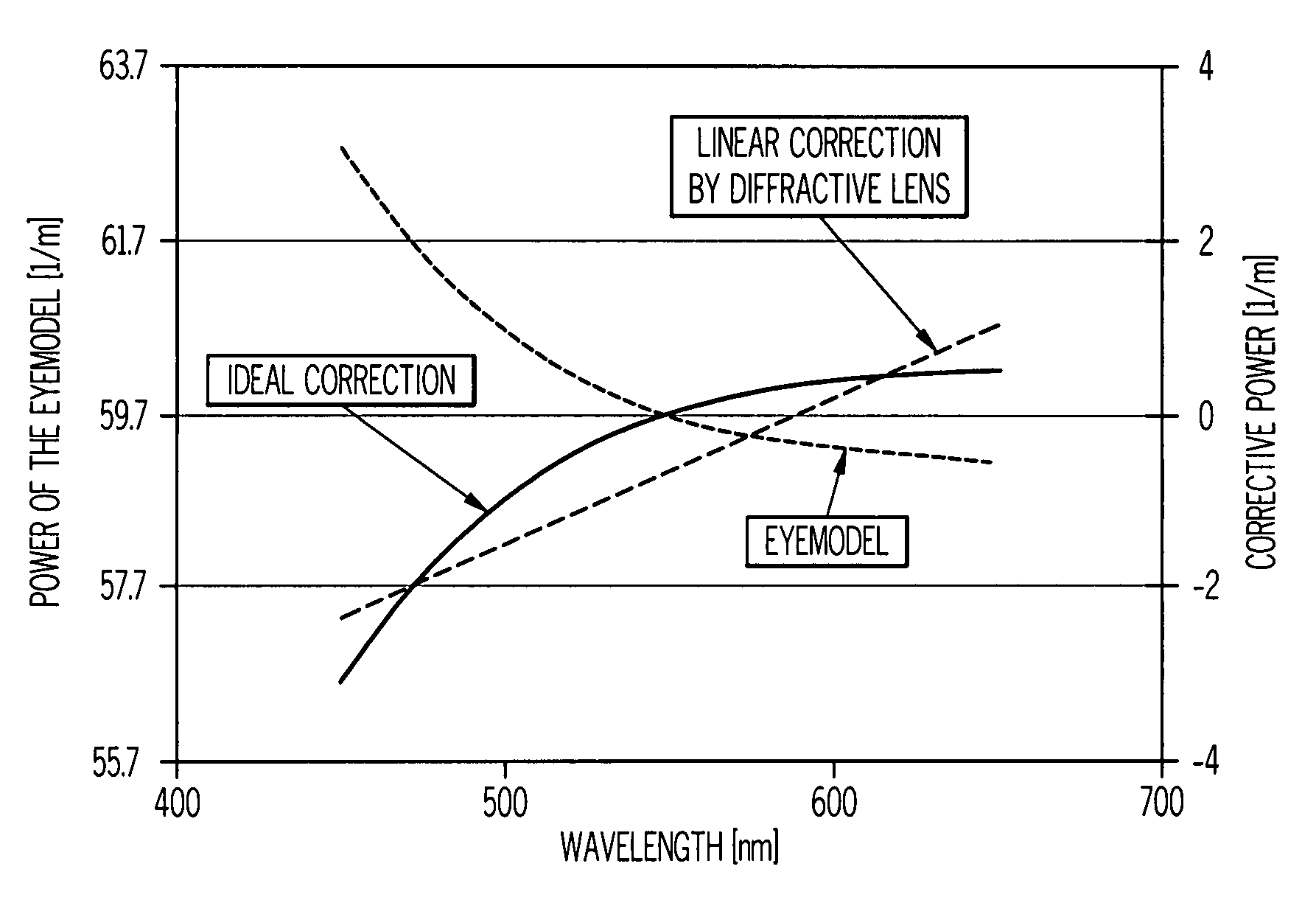Ophthalmic lenses capable of reducing chromatic aberration
a technology of chromatic aberration and ophthalmology, applied in the field of ophthalmology capable of reducing chromatic aberration, can solve the problems of providing the eye with an increase in chromatic aberration, the lens does not compensate for other aberrations,
- Summary
- Abstract
- Description
- Claims
- Application Information
AI Technical Summary
Benefits of technology
Problems solved by technology
Method used
Image
Examples
example 1
[0073]A new lens is optimized using the photopic luminosity function of the aphakic eye as the spectral sensitivity merit function.
Background Theory:
[0074]Both the cornea and the refractive intraocular lens (IOL) have a positive chromatic aberration, which means that the focal length increases with longer wavelength. When the eye model of Navarro (1985) is used, together with a 20 diopter silicone refractive intraocular lens instead of the natural lens, the chromatic aberration can be estimated by calculating the power of the eye model at different wavelengths. A graph similar to FIG. 1 will be the result. A diffractive profile has a negative chromatic aberration. The profile consists of a number of rings (zones). For a diffractive lens working in the 1st diffraction order, the power of lens can be defined by:
[0075]P=2*λw2
Where P is the lens power, λ is the design wavelength (m) and w is the Half-width (radius) of the first zone of the diffractive profile. The chromatic aberration (...
example 2
[0086]A new lens is optimized using the photopic luminosity function of the aphakic eye as the spectral sensitivity merit function including a chromophore material
[0087]This example illustrates the procedure followed when the refractive / diffractive lens material contains a chromophore (meaning the lens will have a wavelength dependent transmission function). In this example a refractive / diffractive intraocular lens design is again optimized using a spectral merit function to weight the wavelength dependent MTF following a similar procedure as that outlined in Example 1. In this case the combination of the chromophore and the diffractive portion of the lens optimized using a spectral merit function better minimize chromatic aberration and maximize the polychromatic MTF. Because the material contains a spectral filter that may filter out certain wavelengths completely or partially the wavelengths affected will contribute less to the polychromatic MTF. For optimization purposes the spe...
example 3
[0096]Avoiding bifocal behavior of a diffractive lens element
[0097]For a design lens of Example 1 (monofocal), the diffractive lens element has an efficiency, which depends on the wavelength of the light. At the design wavelength, the efficiency of the lens is 100%, which means that 100% of the light is directed to the intended focus point. At other wavelengths, the efficiency of the 1st order focus decreases, while the efficiency of foci of the other diffractive orders increase. In FIG. 7, the change in efficiency for the different diffractive orders is depicted. The graph shows that for certain wavelengths, the lens becomes bifocal.
[0098]In FIG. 7, the diffractive lens has a design wavelength of 550 nm. This lens is bifocal at wavelength of 397 nm and 1070 nm. Only the lower wavelength (397 nm) lies within the range of visible light.
[0099]There are two ways to avoid a bifocal behavior in the visible light range:[0100]1. Block the light at the specific wavelengths. For example, in ...
PUM
 Login to View More
Login to View More Abstract
Description
Claims
Application Information
 Login to View More
Login to View More - R&D
- Intellectual Property
- Life Sciences
- Materials
- Tech Scout
- Unparalleled Data Quality
- Higher Quality Content
- 60% Fewer Hallucinations
Browse by: Latest US Patents, China's latest patents, Technical Efficacy Thesaurus, Application Domain, Technology Topic, Popular Technical Reports.
© 2025 PatSnap. All rights reserved.Legal|Privacy policy|Modern Slavery Act Transparency Statement|Sitemap|About US| Contact US: help@patsnap.com



